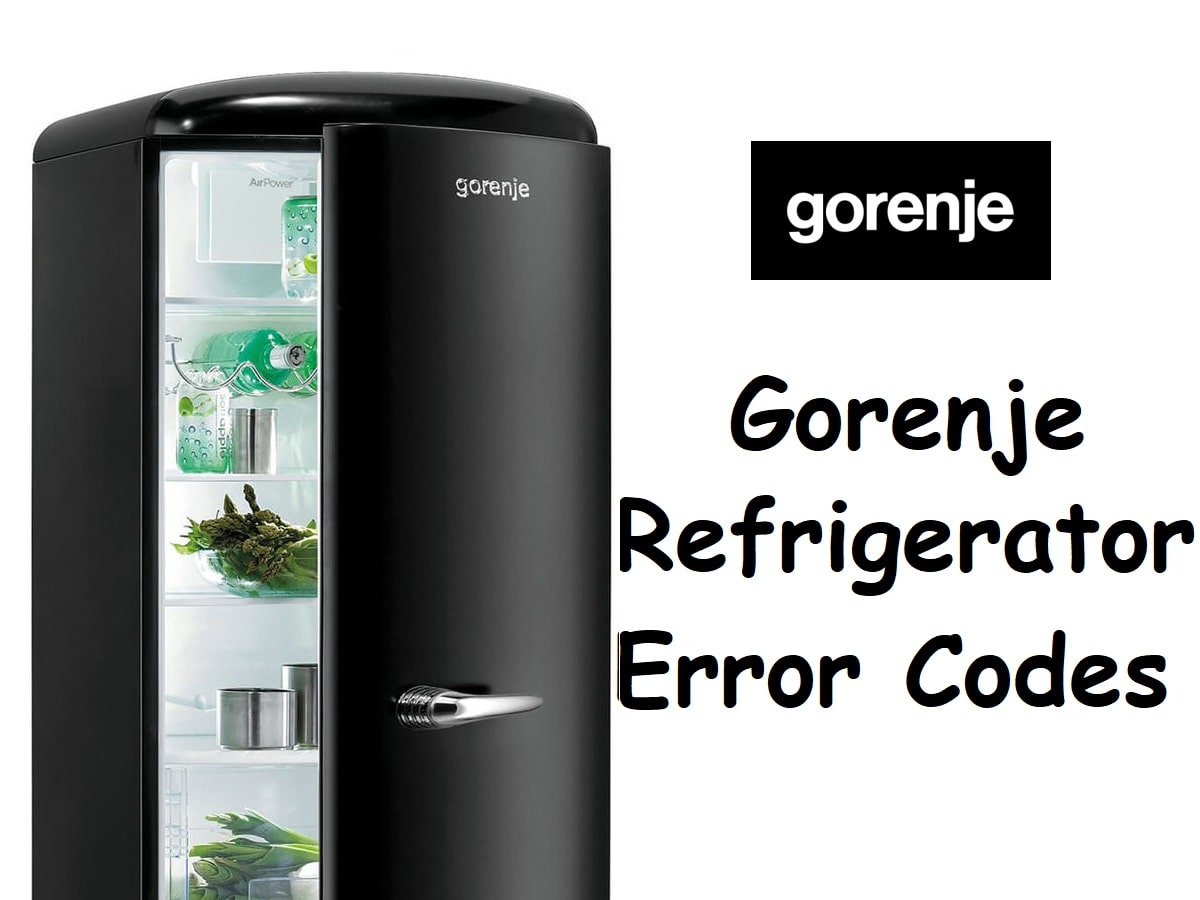Gorenje refrigerator error codes help users monitor the health of their appliances and identify potential issues without the need for examples. These codes are used to control various functions and each one represents a specific malfunction. Refrigerator users, when they understand these codes, can quickly troubleshoot their problems or seek technical assistance. This article aims to provide Gorenje refrigerator owners with this essential information to enhance the performance and durability of their appliances.
Most Common Codes
| Problem | Cause or remedy |
|---|---|
| Appliance is connected to the power mains but it does not work. | Make sure there is voltage in the power outlet and that the appliance is switched on. |
| Cooling system operates continuously for a long period of time | Too high environment temperature. |
| Door opened too frequently or too long. | |
| Door not closed correctly | |
| Too much fresh food inserted at once | |
| Sensor in the refrigerator (A or B) blocked by fresh food. | |
| Insufficient compressor and condenser cooling. | |
| Excessive build-up of ice on the back wall of refrigerator interior can be a result of the following | Door opened too frequently or too long. |
| Warm food placed in the refrigerator | |
| Food in contact with the back interior wall of the refrigerator. | |
| Poor door sealing. | |
| If the seal is dirty or damaged, clean it or replace it | |
| Build-up of ice or frost in the freezer interior may be a result of the following | Door opened too frequently or too long |
| Door not properly closed | |
| Poor door sealing | |
| If the seal is dirty or damaged, clean or replace it | |
| Condensate (dew) on the shelf above the drawers | This is a transient phenomenon which cannot be entirely avoided in periods of high environment temperature and humidity |
| Open the humidity control slider | |
| Place the food in to bags or other airtight packaging | |
| Water leaking from the refrigerator | Clogged water discharge opening or water dripping past the water gutter |
| Clean the clogged opening, for example using a plastic straw | |
| If a thick layer of ice builds up, defrost the appliance manually | |
| The B key will flash (applies to control unit 4) | Door opened too frequently or too long |
| Door not closed correctly (possible impurities on the seal, misaligned door, damaged seal etc.) | |
| A longer power failure | |
| Too much fresh food inserted at once | |
| Door is difficult to open | If you are trying to open the freezer door after just having closed it, this could be difficult to do |
| Door is difficult to open | If LED lighting does not work, call a service technician |
| Do not attempt a repair of the LED lighting yourself, as there is danger of contact with high voltage | |
| Indication of error code on the display (only with some models) | If E appears on the display, call a service technician. |
| Temperature in the freezer too high | Set the manual flap (located behind the fruit and vegetables bin) by pressing the button and moving it to position 1 (only with some models) |
| Temperature in the refrigerator too high | Set the manual flap (located behind the fruit and vegetables bin) by pressing the button and moving it to position 3 (only with some models). |
Cleaning The Appliance
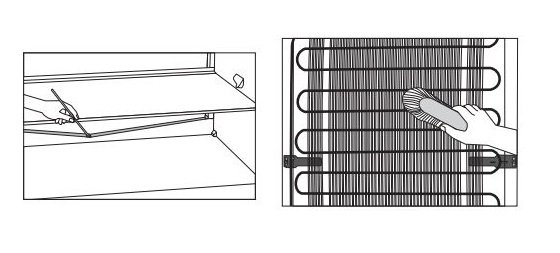
Before cleaning, unplug the appliance from the power mains – switch off the appliance (see chapter Switching the Appliance On/Off) and unplug the power cord from the wall outlet.
Use a soft cloth to clean all surfaces. Cleaners that contain abrasive substances, acids, or solvents are not suitable for cleaning as they may damage the surface.
Clean the appliance exterior with water or a mild solution of suds. Lacquer-coated and aluminium surfaces may be cleaned with lukewarm water to which you have added a mild detergent. Use of cleaners with low alcohol content is allowed (e.g. window cleaners). Do not use cleaners containing alcohol for cleaning plastic materials.
Appliance interior can be cleaned with lukewarm water to which you can add some vinegar.
- A gutter and an opening through which the water from thawed ice fl ows are located underneath the cooling panel that cools the refrigerator interior. The gutter and the opening may not be clogged. Inspect them often and clean if necessary (e.g. with a plastic straw).
- Frost or ice build-up, 3-5 mm thick, will increase power consumption. Therefore, it should be regularly removed (does not apply to NO FROST freezer). Do not use any sharp objects, solvents, or sprays.
- The condenser unit mounted on the (exterior) back wall should always be kept clean, free of dust or deposits resulting from kitchen smoke or fumes.. Occasionally clean the dust using a soft non-metal brush or a vacuum cleaner.
- After cleaning, switch the appliance back on and insert the food.
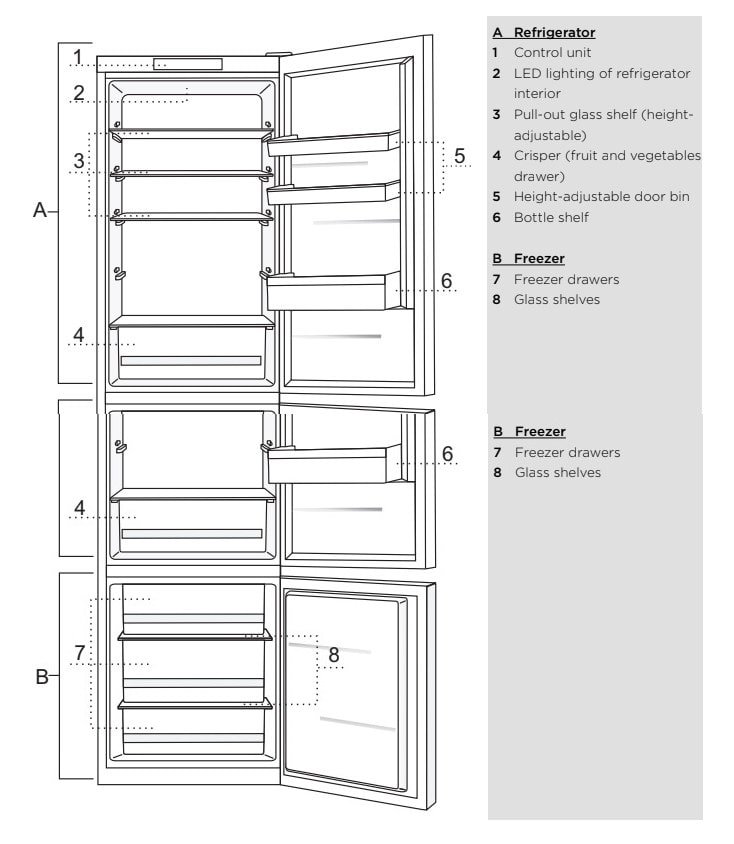
Defrosting A No Frost Freezer
- The NO FROST freezer will defrost automatically. Occasional frost that may appear on the walls will disappear automatically
- Build-up of ice or frost in the freezer compartment can be a result of abnormal use of appliance (door opened too frequently and/or too long, door not properly closed etc.). In this case, unplug the appliance, remove the food from the freezer and protect them from defrosting.
- Clean and dry the freezer interior. Before returning the frozen food into the freezer, switch on the appliance and select the desired setting.
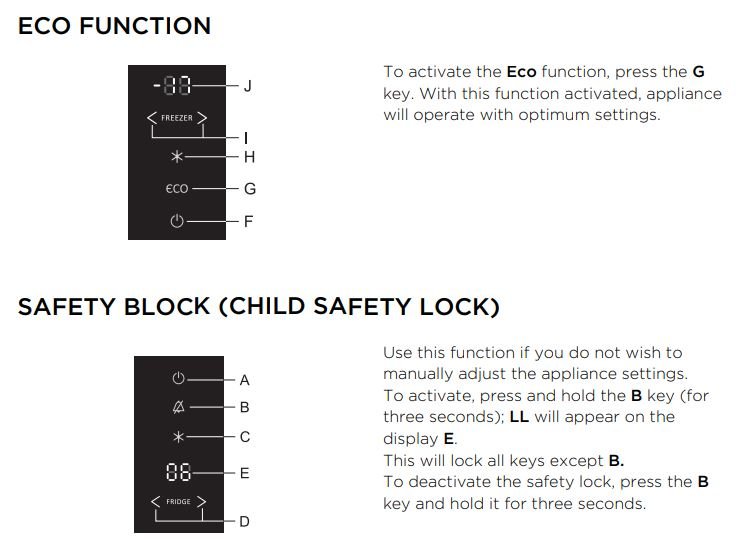
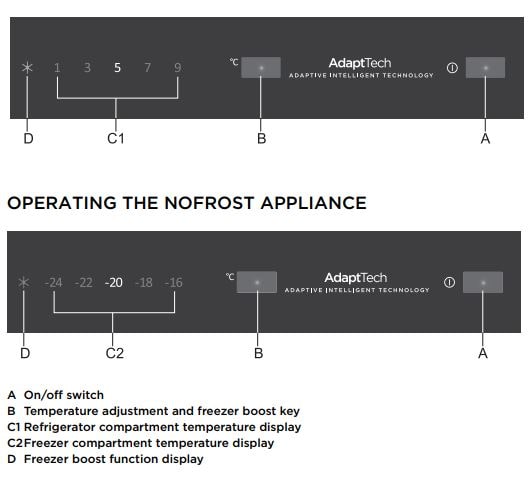
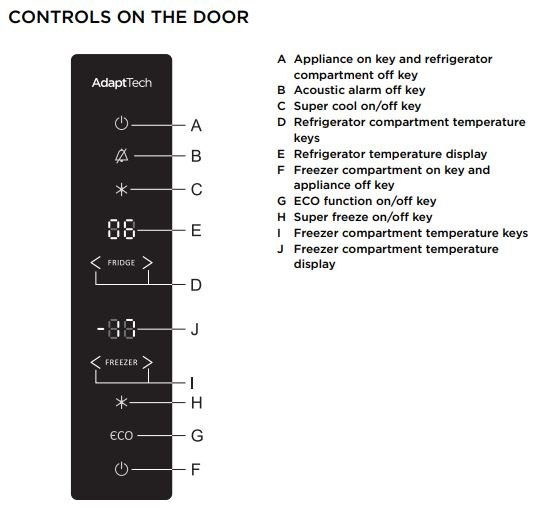
Troubleshooting
If none of the instructions below fixes your problem, call the nearest authorized service center and state the type, model, and serial number found on the rating plate/label which is 445489 located in the appliance interior.
| Problem | Cause |
|---|---|
| Appliance is connected to the power mains but it does not work. | Make sure there is voltage in the power outlet and that the appliance is switched on. |
| Cooling system operates continuously for a long period of time | Too high environment temperature. Door opened too frequently or too long. |
| Excessive build-up of ice on the back wall of refrigerator interior can be a result of the following | Door opened too frequently or too long. Warm food placed in the refrigerator. |
| Build-up of ice or frost in the freezer interior may be a result of the following | Door opened too frequently or too long. Door not properly closed. |
| Condensate (dew) on the shelf above the drawers | This is a transient phenomenon which cannot be entirely avoided in periods of high environment temperature and humidity. It subsides when temperature and humidity are normalized. We recommend cleaning the drawers more frequently and wiping the droplets occasionally. |
| Water leaking from the refrigerator | Clogged water discharge opening or water dripping past the water gutter. |
| The B key will flash | Door opened too frequently or too long. |
| Door is difficult to open | If you are trying to open the freezer door after just having closed it, this could be difficult to do. As you open the door, some cool air escapes from the appliance and it is replaced by warm air from the environment. When this air is cooled, negative pressure is generated which results in problems as you try to open the door. After a few minutes, the condition is normalized and the door can be easily opened again. |
| Door is difficult to open | If LED lighting does not work, call a service technician. Do not attempt a repair of the LED lighting yourself, as there is danger of contact with high voltage! |

